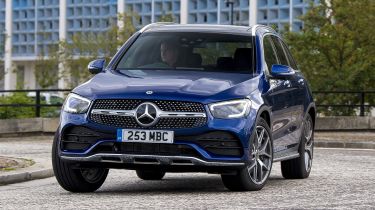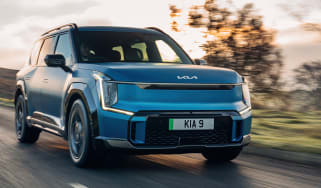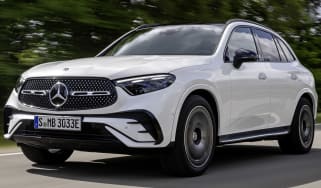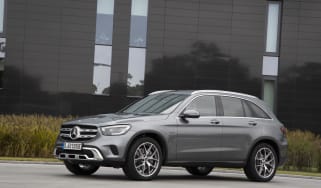Mercedes GLC hybrid (2020-2022) review
The GLC in both 300 e (petrol-electric) and 300 de (diesel-electric) form, and as a coupe or SUV, offers a different take on the luxury plug-in hybrid formula

Pros
- Fast and powerful
- Company-car-tax friendly
- Petrol and diesel available
Cons
- Less agile than BMW
- Step in boot floor
- Expensive
| Model | Electric range | Fuel economy | CO2 emissions |
|---|---|---|---|
| GLC 300 e SUV | 27-28 miles | 117-123mpg | 52-54g/km |
| GLC 300 e Coupe | 26-27 miles | 109-118mpg | 54-59g/km |
| GLC 300 de SUV | 27 miles | 149-157mpg | 48-50g/km |
| GLC 300 de Coupe | 25-26 miles | 135-149mpg | 51-55g/km |
The Mercedes GLC is the three-pointed star’s answer to the BMW X3, Audi Q5, Volvo XC60, Lexus NX and Jaguar F-Pace. Like all of its competitors, the GLC is available as plug-in hybrid, but is uniquely offered with both petrol-electric (GLC 300 e) and diesel-electric (GLC 300 de) power, and comes in both a traditional and practical SUV or stylish Coupe-SUV body shape.
Of course, this is the previous generation of Mercedes’ mid-size luxury SUV. The new second-generation GLC 300 e and 300 de get larger batteries, an 80-mile pure-electric driving range and technology from the S-Class flagship, among other upgrades.
But company-car users should still be happy with the original GLC PHEV: thanks to low CO2 emissions and electric running potential, whichever version you go for, the Benefit-in-Kind (BiK) contributions are drastically lower than they would be for an equivalent purely combustion-engined model.
The petrol GLC 300 e uses a familiar 2.0-litre petrol-electric setup from elsewhere in the Mercedes range (such as the C-Class hybrid), producing a combined 316bhp. The result is a nippy 0-62mph time of just 5.7 seconds – and on the road, the plug-in GLC feels as fast as those figures suggest.
In its default drive mode, the GLC 300 e will prioritise electric power for nearly 30 miles – as long as you aren’t too heavy with your right foot. Leave it in this setting and the intelligent regenerative braking system will read the road ahead, taking care of all but the most evasive braking manoeuvres – all the while feeding energy back into the battery that would otherwise be lost.
That 13.5kWh battery can be topped up in just over two-and-a-half hours with a home wallbox charger, or you can just use a standard domestic socket and still be done comfortably overnight, ready to go for another zero-emissions commute in the morning.
As is the case with a number of plug-in hybrid models, practicality takes a minor hit – the GLC has a small step in the boot floor. And due to the placement of the batteries, there's no underfloor storage, either – so unless you leave them at home, the car’s charging cables must sit alongside your bread and milk in the boot.
Another downside is that, as well as not being as good to drive as its BMW rival, this version of the petrol-electric GLC isn't as efficient as many of its rivals. It may well be that, as is the case with the E-Class executive saloon – the diesel plug-in hybrid option actually makes more sense, particularly for those who regularly exceed the car's pure-electric range on their journeys. For a more detailed look at the GLC hybrid, read on for the rest of our in-depth review...






